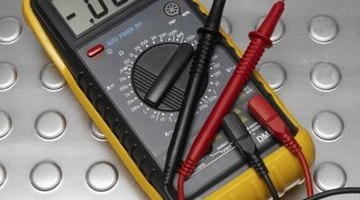How to Test Emergency Light Batteries
Emergency lights are required if your domestic electricity supplies fails. It's important you keep them in an easily accessible place that every family member knows, in case you need to find them in the dark. It's sensible to regularly check your emergency light batteries as you don't want to find they are dead when you need them urgently. While you can simply switch on the emergency lights to test if they work, a more accurate method is to use a multimeter to test the milliamp (mAh) capacity.

-
Open the battery compartment in your emergency lights. All emergency lights vary; some you remove by unscrew the top part that contains the light bulb, others you need to remove a side or base panel. Use a screwdriver if necessary to open and remove the panel.
-
Remove the batteries from the emergency light battery compartment. Place the batteries on a table. You need to test each battery separately, as all the batteries need to have an equal charge. One bad battery affects the power you get from the battery pack.
-
Look on the label of one of the batteries to ascertain its mAh when fully charged. It's usually printed near to where the voltage is given and the battery type. If the mAh isn't mentioned, then you can test the voltage of the battery instead, but it's not as accurate, as voltage remains steady until the battery is about 75 percent discharged; mAh drops as the battery gets used. Make a note of the mAh or the voltage, as appropriate.
-
Turn the dial, or press the button, on your multimeter to set it to measure mAh, if the mAh is on the battery label. If not, then set the meter to measure voltage.
-
Place the metal probes on the ends of the two colored wires from the meter onto the battery terminals. Put the red probe on the battery terminal labeled with a plus sign and the black probe on the terminal labeled with a minus sign.
-
Check the meter reading. The mAh is the same as the mAh on the battery label if it's fully charged. If you're using voltage, it's the same as the voltage on the label unless the battery is nearly discharged. If the voltage is less than on the battery label, get a replacement.
-
Calculate the percentage mAh remaining in your battery to find how charged it is. Divide the reading from the meter by the mAh from the battery label and multiply by 100. For example, if the reading is 500 mAh and the battery label is 1,000 mAh then 500 divided by 1,000 equals 0.5, multiplied by 100 equals 50. This means you have 50 percent capacity. Write down the percentage.
-
Repeat the process for all the batteries. Write down the percentages and compare them. They need to all be within a few percent of each other. If any are lower by more than about 10 percent you need to replace them. If the percentage of mAh remaining is less than 50 percent, get replacements.
References
Tips
- If you need to replace any of the batteries, it's sensible to replace all of them at the same time.
Writer Bio
Stephen Benham has been writing since 1999. His current articles appear on various websites. Benham has worked as an insurance research writer for Axco Services, producing reports in many countries. He has been an underwriting member at Lloyd's of London and a director of three companies. Benham has a diploma in business studies from South Essex College, U.K.
Photo Credits
- Polka Dot Images/Polka Dot/Getty Images
More Articles



